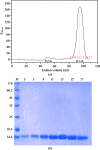Crystal structure of the type IV secretion system component CagX from Helicobacter pylori
- PMID: 28291753
- PMCID: PMC5349311
- DOI: 10.1107/S2053230X17001376
Crystal structure of the type IV secretion system component CagX from Helicobacter pylori
Abstract
Helicobacter pylori, a Gram-negative bacterial pathogen prevalent in the human population, is the causative agent of severe gastric diseases. An H. pylori type IV secretion (T4S) system encoded by the cytotoxin-associated gene pathogenicity island (cagPAI) is responsible for communication with host cells. As a component of the cagPAI T4S system core complex, CagX plays an important role in virulence-protein translocation into the host cells. In this work, the crystal structure of the C-terminal domain of CagX (CagXct), which is a homologue of the VirB9 protein from the VirB/D4 T4S system, is presented. CagXct is only the second three-dimensional structure to be elucidated of a VirB9-like protein. Another homologue, TraO, which is encoded on the Escherichia coli conjugative plasmid pKM101, shares only 19% sequence identity with CagXct; however, there is a remarkable similarity in tertiary structure between these two β-sandwich protein domains. Most of the residues that are conserved between CagXct and TraO are located within the protein core and appear to be responsible for the preservation of this domain fold. The studies presented here will contribute to our understanding of different bacterial T4S systems.
Keywords: CagX; Helicobacter pylori; X-ray diffraction; cagPAI; crystal structure; cytotoxin-associated gene pathogenicity island; type IV secretion system.
Figures







Similar articles
-
C-terminal domain of CagX is responsible for its interaction with CagT protein of Helicobacter pylori type IV secretion system.Biochem Biophys Res Commun. 2015 Jan 2;456(1):98-103. doi: 10.1016/j.bbrc.2014.11.041. Epub 2014 Nov 21. Biochem Biophys Res Commun. 2015. PMID: 25446105
-
Crystal structure of the N-terminal anticodon-binding domain of the nondiscriminating aspartyl-tRNA synthetase from Helicobacter pylori.Acta Crystallogr F Struct Biol Commun. 2017 Feb 1;73(Pt 2):62-69. doi: 10.1107/S2053230X16020586. Epub 2017 Jan 19. Acta Crystallogr F Struct Biol Commun. 2017. PMID: 28177315 Free PMC article.
-
Composition, structure and function of the Helicobacter pylori cag pathogenicity island encoded type IV secretion system.Future Microbiol. 2015;10(6):955-65. doi: 10.2217/fmb.15.32. Future Microbiol. 2015. PMID: 26059619 Free PMC article. Review.
-
CagY-Dependent Regulation of Type IV Secretion in Helicobacter pylori Is Associated with Alterations in Integrin Binding.mBio. 2018 May 15;9(3):e00717-18. doi: 10.1128/mBio.00717-18. mBio. 2018. PMID: 29764950 Free PMC article.
-
The type IV secretion system in Helicobacter pylori.Future Microbiol. 2018 Jul;13:1041-1054. doi: 10.2217/fmb-2018-0038. Epub 2018 Jun 21. Future Microbiol. 2018. PMID: 29927340 Review.
Cited by
-
In Situ Molecular Architecture of the Helicobacter pylori Cag Type IV Secretion System.mBio. 2019 May 14;10(3):e00849-19. doi: 10.1128/mBio.00849-19. mBio. 2019. PMID: 31088930 Free PMC article.
-
A Proposal for a Consolidated Structural Model of the CagY Protein of Helicobacter pylori.Int J Mol Sci. 2023 Nov 26;24(23):16781. doi: 10.3390/ijms242316781. Int J Mol Sci. 2023. PMID: 38069104 Free PMC article.
-
Structure of the Helicobacter pylori Cag type IV secretion system.Elife. 2019 Jun 18;8:e47644. doi: 10.7554/eLife.47644. Elife. 2019. PMID: 31210639 Free PMC article.
-
Identification of Pathogenicity Island Genes Associated with Loss of Type IV Secretion Function during Murine Infection with Helicobacter pylori.Infect Immun. 2020 May 20;88(6):e00801-19. doi: 10.1128/IAI.00801-19. Print 2020 May 20. Infect Immun. 2020. PMID: 32205402 Free PMC article.
References
-
- Akopyants, N. S., Clifton, S., Kersulyte, D., Crabtree, J. E., Youree, B. E., Reece, C. A., Bukanov, N. O., Drazek, E. S., Roe, B. A. & Berg, D. E. (1998). Mol. Microbiol. 28, 37–53. - PubMed
-
- Backert, S., Churin, Y. & Meyer, T. F. (2002). Keio J. Med. 51, Suppl. 2, 6–14. - PubMed
-
- Backert, S. & Selbach, M. (2008). Cell. Microbiol. 10, 1573–1581. - PubMed
MeSH terms
Substances
Grants and funding
LinkOut - more resources
Full Text Sources
Other Literature Sources
Research Materials

